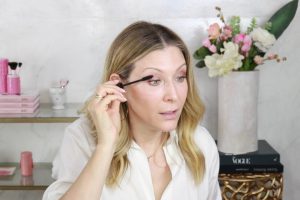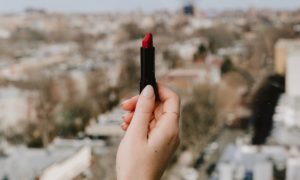Updated 3/4/22
Even if you’ve used a face serum or are currently working your way through one, do you know *exactly* what’s in it — and how it works? Chances are, what’s inside the bottle is a bit of a mystery. So, we’ll start with the short version: Face serums deliver serious skin benefits, thanks to super-high concentrations of key ingredients that work hard to brighten, smooth, moisturize, and more, depending on what your skin needs.
Keep reading to get the full 411 on serum and how it can transform skin.
Your serum need-to-know guide:
- Face serums are targeted formulas that deliver high levels of proven ingredients
- Face serums are lightweight and easily absorbed by skin
- Choose your serum according to your primary skin concern, such as dryness or wrinkles
- Popular serum ingredients include hyaluronic acid, vitamin C, and rosehip seed oil (scroll on to learn how they work magic for your skin!)
- Apply after cleansing and before moisturizing
- Use one serum morning and night, or use two serums separately, one in the morning and another at night
Why Your Skin Needs a Serum
Let’s start with the basics. Face serums are skincare products that deliver high concentrations of key ingredients in order to target a specific skin concern, such as dullness, dry skin, wrinkles, and more. “The ingredients in serums, such as antioxidants and peptides, are often potent, well-known, and studied to improve the skin concern,” says NakedPoppy research scientist Marisa Plescia.
Also setting serums apart is their unique texture. “With the lightweight nature and being made up of ingredients with usually smaller molecular sizes, they tend to absorb quickly and efficiently into the layers of the skin,” explains Plescia. That, as well as the high concentration of key ingredients, distinguish face serums from other types of skincare products.
There are two primary types of face serums: Water-based or oil-based. Water-based serums tend to be more common and more hydrating, thanks to their high water content.
On the other hand, “oil-based serums are mostly formulated with carrier oils combined with active ingredients,” says Plescia. “They are often rich in texture, but still fluid and liquid. Oil-based serums usually contain little to no water content and can be spread easily over skin.” Whichever one you choose is largely a matter of preference and the concern you’re addressing.
What You’ll Find in a Good Serum
Since the whole point of serums is to target specific concerns, think accordingly. “You want your serum to be condition-specific,” says NakedPoppy skin specialist Tara Parenti. “It should target your concerns and contain active ingredients that will work towards correction and prevention.” Friendly reminder that when you take the 3-minute NakedPoppy assessment, you share your skin concerns and will automatically be recommended serums targeted to your specific skin needs.
Here, a rundown of the most powerful ingredients you may see and how they can help.
Hyaluronic Acid
Great for: Dry skin
Hyaluronic is one of the best-known humectants (molecules that can absorb water from the air and help hydrate and even plump skin) and naturally found throughout the body. “In addition to hydrating the skin, HA can help reduce the appearance of wrinkles and fine lines,” says Plescia.
Find it in: Indie Lee I-Waken Eye Serum
Rosa Rubiginosa Seed Oil
Great for: Mature skin, dry skin
A versatile oil that works for all skin types, rosehip seed oil is rich in fatty acids, including linoleic acid, and trans-retinoic acid (a natural derivative of vitamin A). In addition to deeply moisturizing skin, “the higher level of linoleic acid is suited well for acne-prone or oily skin, as studies indicate that individuals with breakouts are deficient in linoleic acid,” says Plescia. Plus, it helps reduce the appearance of fine lines and wrinkles as well as hyperpigmentation.
Find it in: NakedPoppy Revitalize Organic Facial Oil
Vitamin C
Great for: Dull skin, mature skin
This hardworking ingredient offers a multitude of benefits: It boosts collagen production, brightens and evens out skin tone, and offers even antioxidant protection. “Its ability to neutralize free radical formation as an antioxidant can help the skin respond to oxidative damage from environmental aggressors, such as the sun and pollution, as well as inhibit free radical formation,” says Plescia. “The generation of free radicals is highly connected to skin aging.”
Find it in: Indie Lee Daily Vitamin Infusion
Grapeseed Oil
Great for: Stressed skin
Grapeseed oil is a no-brainer for congested skin or breakouts. Like rosehip seed oil, “it’s high in linoleic acid, which, in addition to fortifying the skin’s barrier and helping to reduce water loss from the skin, may help with acne,” says Plescia. “Studies have found most people prone to breakouts are actually deficient in linoleic acid in their sebum and thus topical use of linoleic acid may reduce acne breakouts. Some have also shown linoleic acid to be anti-inflammatory, which is great for inflamed and red skin often associated with breakouts.”
Find it in: Odacité Gr+G Oily/Acne Prone Grapeseed Grapefruit Serum Concentrate
Lactic Acid
Great for: Dull skin
Lactic acid is a type of alpha hydroxy acid, which, says Plescia, “can exfoliate the skin, removing dead skin cells and promoting new skin cells, which helps to leave skin renewed and healthier.” It can help address a range of skin concerns, including uneven skin tone and texture, pores, acne or blemishes, and fine lines and wrinkles. It even has moisturizing properties, too.
Find it in: Ere Perez Quandong Green Booster Serum
The Best Way to Apply Your Serum
In your routine, layer serum after cleansing skin and applying a toner or essence, if you use one. It should go before your moisturizer, which in turn seals in all those key ingredients into skin.
You’re welcome to use the same serum once or twice a day, or one serum in the morning and another at night (if you want to target two concerns). “Some serums have ingredients in them that are best for evening use because certain ingredients can make you sun sensitive, such as a retinol,” notes Parenti.
Now, for actually applying your serum: “Always dampen your skin first and then immediately apply your serum and other finishing products,” she says. “This will actually enable you to use less serum.”
She recommends dispensing a few drops of serum into one tightly cupped hand. Then, use your middle and ring fingers on the other hand to scoop up the serum and massage it into your face. (“Imagine as if your cupped hand is your mixing bowl and your fingers are a brush,” she says.)
At this point, you can also use a gua sha or face roller if you’d like to work it in even further. Follow it up with moisturizer and you’re all set — ready to reap the benefits of this powerhouse product.






Comments